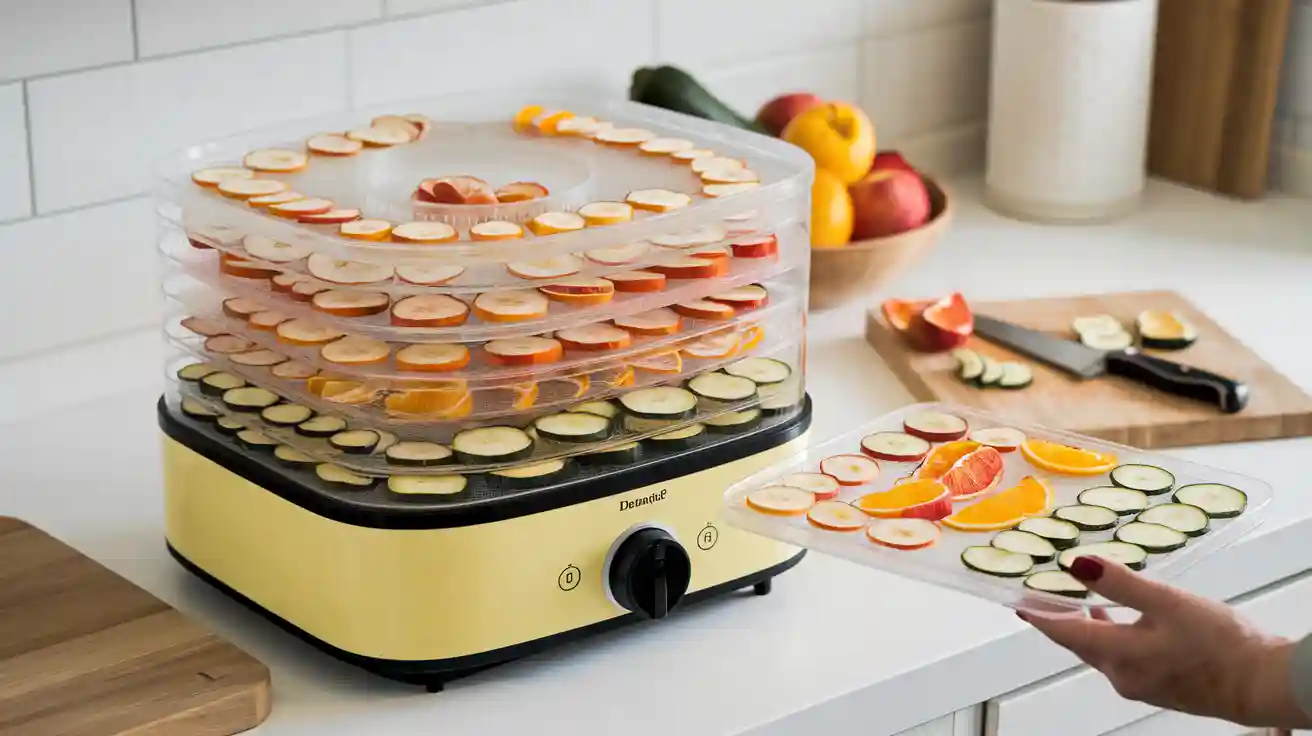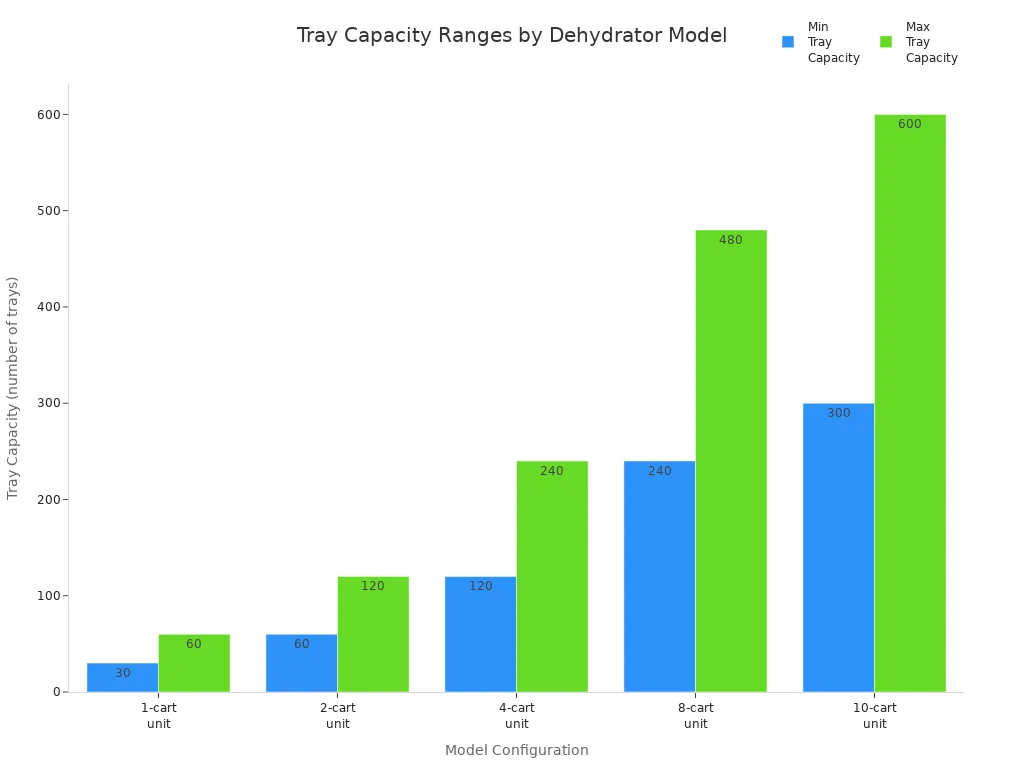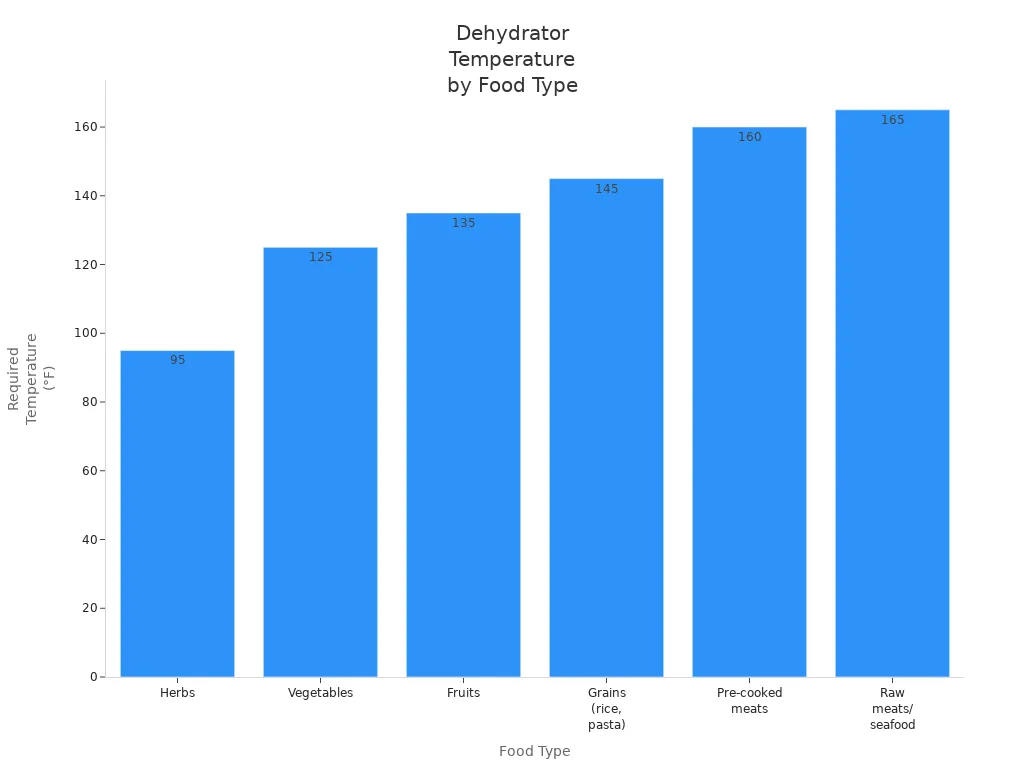
You want a dehydrator food dehydrator that fits your kitchen and lifestyle. The right size and features make a big difference. With the best food dehydrator, you get benefits like healthy snacks and easy storage. Think about the benefits of food dehydrators and the main factors to consider before choosing.
Key Features for the Best Food Dehydrator
Capacity and Number of Trays
When you pick a dehydrator food dehydrator, you want to think about size and capacity first. The number of trays tells you how much food you can dry at once. Some models have just a few trays, while others have hundreds. Here’s a quick look at what you might find:
| Model Configuration | Tray Capacity Range (number of trays) | Total Tray Area Range (sq. ft) |
|---|---|---|
| 1-cart unit | 30 – 60 | 94 – 188 |
| 2-cart unit | 60 – 120 | 188 – 375 |
| 4-cart unit | 120 – 240 | 375 – 750 |
| 8-cart unit | 240 – 480 | 750 – 1500 |
| 10-cart unit | 300 – 600 | 938 – 1875 |
You can see that multi-tray food dehydrators come in many sizes. If you have a big family or want to dry large batches, you might want a model with more trays. For smaller kitchens, a compact unit works better. Here’s a chart to help you compare:

Power, Wattage, and Drying Efficiency
The heating element is the heart of your food dehydrator. More power means faster drying, but it also uses more energy. When you add more trays, you might think you can dry more food at once. But, as you stack up multiple trays, the air and heat can have trouble reaching every corner. This can lead to uneven drying. Sometimes, only 60–70% of the trays dry food evenly. Some people use several smaller dehydrators instead of one big one to get better results. Newer technologies, like microwave drying, help solve these problems, but most home models use a standard heating element.
Tip: If you want the best drying efficiency, don’t overload your trays. Spread food out in a single layer for even results.
Adjustable Temperature Control and Timer
You want your dehydrator to have a temperature setting that matches the food you’re drying. Some foods need low heat, while others need more. Adjustable controls let you pick the right temperature for fruit, meat, or herbs. A timer is another convenient feature. It lets you set the drying time and walk away. Higher-end models often have digital timers and precise controls. This makes it easier to get perfect results every time.
Airflow Design and Mesh Trays
Airflow is a big deal in any food dehydrator. Good airflow means every tray dries food evenly. Some dehydrators push air from the bottom, while others use a fan in the back. Mesh trays help air move around each piece of food. Removable trays make it easy to check your food or clean up after you finish. If you want the best results, look for a model with a strong fan and well-designed airflow.
Ease of Use, Cleaning, and Build Quality
You want a dehydrator that’s easy to use and simple to clean. Removable trays and dishwasher-safe parts save you time. Build quality matters, too. A sturdy dehydrator lasts longer and works better. High-quality materials help your machine stand up to daily use. If you pick a model with solid construction, you’ll have fewer breakdowns and better food every time. Customer reviews can help you spot a reliable food dehydrator.
- High-quality materials mean your dehydrator lasts longer.
- Strong build helps the machine handle heavy use.
- Good construction keeps your food safe and your machine running smoothly.
Noise Level and Kitchen Fit
Some food dehydrators can be noisy, but many new models run quietly. You don’t want a loud machine in your kitchen. Here’s a table showing the noise levels of popular models:
| Model | Noise Level (dB) | Noise Comparison |
|---|---|---|
| Excalibur 3900 | 40 – 48 | Quiet library / near silent |
| Nesco FD-75A | 45 | Light rainfall |
| Cosori CO137-FD | 42 – 50 | Quietest option / normal conversation |
| Presto 06300 | 55 | Background music |
Most household dehydrators run between 40 and 70 decibels. The quietest models sound like a library or gentle rain. If you want a peaceful kitchen, look for a model with a low noise rating.
Price and Value for Use
Price is one of the most important factors to consider. You want the best value for your money. Lower-priced food dehydrators usually have fewer trays, plastic parts, and basic controls. As you move up in price, you get more trays, better materials, and longer warranties. Here’s a quick guide:
| Price Range (Current) | Tray Count (Base / Max) | Timer Feature | Material | Warranty |
|---|---|---|---|---|
| $79.51 – $389.95 | 5 to 10 / up to 30 | None to Digital/12h | Plastic to Stainless Steel | 1 to 10 years |
You get what you pay for. If you plan to use your dehydrator food dehydrator often, it makes sense to invest in a model with more convenient features and a strong heating element. Always check the warranty and read reviews before you buy.
Note: Think about your needs, your kitchen space, and your budget. The right food dehydrator will make drying food easy and fun.
Comparing Food Dehydrator Types and Matching to Your Needs

Vertical (Stackable) Dehydrator vs. Horizontal (Box-Style) Dehydrator
When you start looking at food dehydrators, you’ll notice two main types. You have vertical (stackable) dehydrators and horizontal (box-style) dehydrators. Each design has its own benefits and works best for different needs.
A vertical or stackable food dehydrator has trays that stack on top of each other. Air flows from the bottom or top, moving through each tray. These models save space and let you add or remove trays as needed. They fit well in small kitchens and cost less than most horizontal models.
A horizontal or box-style dehydrator looks more like a small oven. Trays slide in like shelves, and a fan at the back pushes air across each tray. This design gives you even airflow and steady temperature. You don’t need to rotate trays, and you get the same results on every level.
If you want to dry different foods at once, a horizontal food dehydrator keeps flavors from mixing. You get even drying and less hassle.
Pros and Cons of Each Dehydrator Type
Let’s break down the benefits and drawbacks of both types of food dehydrators. This helps you pick the right one for your kitchen and lifestyle.
Vertical (Stackable) Dehydrator:
- More affordable, often under $100.
- Compact and saves countertop space.
- Stackable trays let you adjust capacity.
- Easy to store and simple to use.
- Great for beginners.
- Works well for drying delicate items like herbs, fruits, and vegetables.
- Some uneven heat distribution, but still good for small families or casual use.
Horizontal (Box-Style) Dehydrator:
- Even airflow and temperature on every tray.
- No need to rotate trays.
- Prevents flavor mixing between different foods.
- Best for large batches and a wide range of foods.
- Usually bigger and takes up more space.
- Costs more than vertical models.
| Feature | Vertical (Stackable) | Horizontal (Box-Style) |
|---|---|---|
| Price | Lower | Higher |
| Space Needed | Less | More |
| Airflow | Can be uneven | Very even |
| Tray Rotation Needed | Sometimes | Rarely |
| Best For | Beginners, small batches | Large batches, mixed foods |
Matching Dehydrator Features to Family Size and Food Types
You want your food dehydrator to match your family’s needs and the types of food you plan to dry. If you have a big family or want to make lots of dehydrated snacks, a horizontal dehydrator with more trays works best. For a single person or couple, a compact vertical model does the job.
Different foods need different features. Herbs need low heat to keep their flavor. Fruits and vegetables need steady, moderate heat. Meats need high temperatures for safety. Adjustable temperature controls and timers help you get the best results for each food.
| Food Type | Required Dehydrator Feature (Temperature Setting) | Reason for Specific Feature Requirement |
|---|---|---|
| Herbs | Low temperature (~95°F) | Preserves delicate flavors and essential oils |
| Vegetables | Moderate temperature (~125°F) | Retains color and nutrients while drying evenly |
| Fruits | Slightly higher temperature (~135°F) | Maintains sweetness and nutritional value |
| Grains (rice, pasta) | Higher temperature (~145°F) | Ensures thorough dehydration without texture compromise |
| Pre-cooked meats | High temperature (~160°F) | Ensures safety and proper drying |
| Raw meats/seafood | Highest temperature (~165°F) | Eliminates pathogens for food safety |

Tip: Thinly slice fruits for even drying. Steam vegetables before drying to keep their color and nutrients. Pretreat fruits with ascorbic acid to stop browning.
Frequency of Use and Batch Size
How often you use your food dehydrator changes what you need. If you dry food every week, you want a durable model that can handle regular cleaning. Using your dehydrator for small batches often means higher electricity bills and more maintenance. If you dry large batches less often, you save energy and your machine lasts longer.
- Frequent use in small batches means more cleaning and higher energy costs.
- Large batch processing is more energy-efficient and helps your dehydrator last longer.
- Seasonal use keeps bills low most of the year, but you may use more power during harvest time.
- If you use your dehydrator all the time, pick an energy-efficient model and keep up with maintenance.
- Features like timers and temperature controls help you avoid overuse and keep your machine running smoothly.
Space, Storage, and Practical Checklist for Choosing
Before you buy, think about where you’ll keep your food dehydrator. Vertical models fit in tight spaces and store easily. Horizontal models need more room but offer more capacity. Make a checklist to help you decide:
- How much counter space do you have?
- How many people will eat the dehydrated snacks?
- What types of food will you dry most often—herbs, fruits, vegetables, or meats?
- How often will you use your dehydrator?
- Do you need adjustable temperature and timer features?
- Will you need to store the dehydrator when not in use?
Note: The best food dehydrator fits your kitchen, matches your food goals, and makes healthy snacks easy. Think about your space, your family, and your favorite foods before you choose.
- You want the best food dehydrator for your kitchen and goals.
- Use your checklist, compare features, and trust your needs.
- When you use your new food dehydrator, you make snacks and meals easy.
Ready to use your knowledge? Start shopping and enjoy the process!
FAQ
How do you clean a multi-tray food dehydrator?
Take out the trays. Wash them with warm, soapy water. Wipe the inside with a damp cloth. Let everything dry before you put it back together.
Can you dry different foods at the same time?
You can, but strong smells might mix. Try to group similar foods together. Use a horizontal dehydrator if you want to keep flavors separate.
What foods work best in a dehydrator?
Fruits, vegetables, herbs, and jerky dry well.
Try apples, bananas, tomatoes, or beef strips for tasty snacks!


